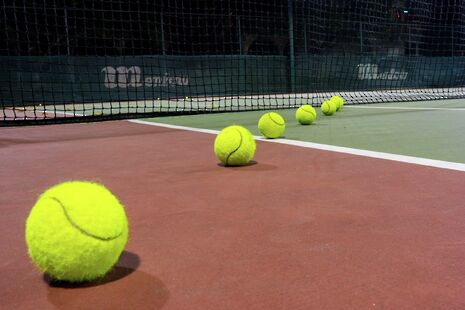Tennis balls cause chaos
Cambridge scientists investigate tennis balls to discover more about entropy

“How many ways can you arrange 128 tennis balls in a given volume?” At first this may not seem like the most useful question for a team of scientists to puzzle over, but stick with it.
A team of Cambridge scientists have recently published a paper investigating these tennis balls to discover more about entropy, a fairly mysterious concept. Entropy can be thought of as a measure of the disorder of any system; a collection of particles, the contents of a test tube or the remains of those cheesy chips slowly turning your gyp room into a biohazard. Its prime application is as a predictive tool in the physical sciences.
Entropy can be quantified as the number of ways of arranging a system. Imagine a very limited sock situation: I have two socks which may be in or out of the drawer. There are three disordered arrangements – either one or both of the socks are on the floor – but only one ordered arrangement – both in the drawer. This means that the ordered system has less entropy than the disordered. According to the laws of thermodynamics, entropy always increases, our socks naturally become more disordered, and we must put in energy to reverse this.
On a microscopic level this descent into disorder happens spontaneously (those socks literally fly out my drawers). However, when it comes to the arrangement of sand in a dune or a stack of 128 tennis balls, something needs to cause the change, such as the wind or Federer’s forehand. This area of physics tries to predict macroscopic events by measuring the disorder of all the particles in the system. However, attempts to do this have – until now – proved futile. Stefano Martiniani, a member of the research team and a fellow at St John’s, explains: “The brute force way of doing this would be to keep changing the system and recording the configurations. Unfortunately, it would take many lifetimes before you could record it all.”
Re-enter the 128 tennis balls and a novel technique. The team analysed a subsection of the problem, looked at its possible arrangements and their associated probabilities, and then extrapolated to approximate, to a very high degree of accuracy, the number of ways of arranging all 128 balls. This dramatically simplified the calculation and allowed the computers to produce an answer. The number of possible arrangements is one followed by 250 zeros – an unquadragintilliard; a number so large it exceeds the number of particles in the universe.
This answer is slightly meaningless on its own: who needs that many tennis balls anyway? The possible applications of this approximation method are manifold. Martiniani explains “Granular materials [such as sand, soil or snow] themselves are the second most processed kind of material in the world after water, and even the shape of the surface of the Earth is defined by how they behave.” Phenomena such as avalanches could eventually fall under this remit. It may be a long time before large scale analysis is possible, but the applications could stretch to mathematics, string theory, cosmology and artificial intelligence. Not such an academic curiosity after all.
 News / Copycat don caught again19 April 2024
News / Copycat don caught again19 April 2024 Interviews / ‘People just walk away’: the sense of exclusion felt by foundation year students19 April 2024
Interviews / ‘People just walk away’: the sense of exclusion felt by foundation year students19 April 2024 News / AMES Faculty accused of ‘toxicity’ as dropout and transfer rates remain high 19 April 2024
News / AMES Faculty accused of ‘toxicity’ as dropout and transfer rates remain high 19 April 2024 Theatre / The closest Cambridge comes to a Drama degree 19 April 2024
Theatre / The closest Cambridge comes to a Drama degree 19 April 2024 News / Acting vice-chancellor paid £234,000 for nine month stint19 April 2024
News / Acting vice-chancellor paid £234,000 for nine month stint19 April 2024




